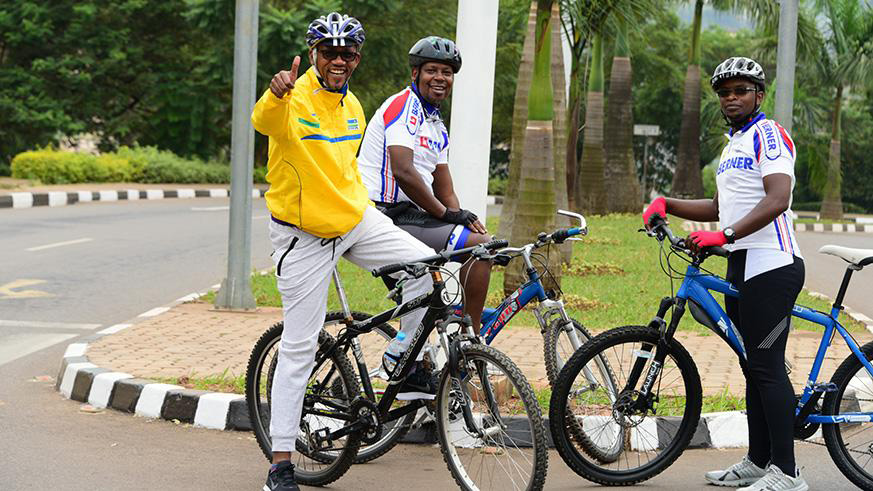

Cerebrovascular accident, or stroke, constitutes the second leading cause of mortality worldwide. Low and middle-income countries bear most of the stroke burden globally.
According to experts, a stroke can happen in two main ways; that is, something blocks the flow of blood or something causes bleeding in the brain.
Prof Joseph Mucumbitsi, a cardiologist and the president of Rwanda Heart Foundation, who also heads NCD Alliance in Rwanda, says there are two types of strokes that include transient ischemic attack (TIA) and haemorrhagic.
In a transient ischemic attack, he says there is a temporary interruption in the blood flow to a part of the brain.
"While most TIAs last only a few minutes, they account for 80 per cent of all strokes, and warning signs of a TIA are the same as the warning signs of a stroke,” he says.
On the other hand, during a haemorrhagic stroke, an artery in the brain bursts.
He explains that haemorrhagic strokes could be intracerebral haemorrhage, which happens when a blood vessel in the brain leaks blood into the brain, or subarachnoid - where bleeding occurs under the outer membranes of the brain and into the thin fluid-filled space that surrounds the brain.
Globally, 15 million people suffer from stroke annually, among them, five million die, five million recover, while five million are left disabled.
In 2016, there were 5.5 million deaths where 2.9 were men and 2.6 female.
What you should know
Francis Habumugisha Goodrich, PhD Public health practitioner in Kigali, says stroke occurs when the blood supply to part of the brain is interrupted or reduced, preventing brain tissue from getting oxygen and nutrients. Brain cells begin to die in minutes.
To understand better, he says stroke is a medical emergency, and prompt treatment is crucial, early action can reduce brain damage and other complications.
Habumugisha says there are risk factors that can cause a stroke and that physical inactivity is one of them.
He explains that not getting enough physical activity can lead to other health conditions that can raise the risk for stroke.
These health conditions, he says, include obesity, high blood pressure, high cholesterol, and diabetes.
Because of this, he advises that regular physical activity can help lower one’s chances for stroke, therefore, adopting the culture of sports is vital.
Mucumbitsi says about 87 per cent of strokes worldwide are caused by narrowed or clogged blood vessels in the brain that cut off the blood flow to brain cells.
"This is an ischemic stroke; high blood pressure causes damage to the inner lining of the blood vessels. This adds to any blockage that is already within the artery wall,” he says.
He further explains that ischemic stroke is the most common type, it is usually caused by a blood clot that blocks or plugs a blood vessel in the brain. This keeps blood from flowing to the brain. Within minutes, brain cells begin to die.
Another risk factor, Mucumbitsi says, is tobacco use, explaining that this comes about when cigarette smoke, carbon monoxide, and nicotine enter the bloodstream.
Because of this, he says, carbon monoxide reduces the amount of oxygen in the blood, and the nicotine makes the heart beat faster—raising one’s blood pressure, which increases the risk of a stroke.
Meanwhile, worldwide, tobacco smoking (including second-hand smoke) is one of the top three leading risk factors for disease.
Studies show that men under 50 who smoke are 88 per cent more likely to have a stroke than those who never smoked.
Studies also suggest that within two to five years of quitting smoking, one’s stroke risk is reduced to about the same as that of a non-smoker.
Another risk factor of stroke, Habumugisha says, is diabetes. He explains that diabetes means one has too much sugar in their blood.
"This is because having too much sugar in the blood damages the blood vessels. It can make the blood vessels become stiff and also cause a build-up of fatty deposits, he says.
Heart diseases, weight, and medications are some of the other risks factors of stroke.
Signs
Janvier Rusizana, a general practitioner at La Nouvelle Clinic in Remera, Kigali, says signs and symptoms of stroke include sudden numbness or weakness of the face, arm or leg, especially on one side of the body.
There is also sudden confusion, trouble speaking or understanding speech.
Sudden trouble seeing in one or both eyes, sudden trouble walking, dizziness, and loss of balance or coordination, Rusizana says, are all signs of a stroke.
Another sign of stroke, he says, is sudden severe headache with no known cause.
Personal prevention
Habumugisha advises that it’s important to take moderate physical activity for at least 30 minutes, three times a week.
He goes on to add that avoiding tobacco use and exposure to environmental smoke is important.
If one is already smoking, he says quitting is important for the sake of their health.
Another important aspect, he says, is that one should choose a diet rich in fruits, vegetables, and potassium, and avoid saturated fats.
How it is treated
Rusizana says treatment consists of blood thinners.
He adds that early treatment with medication like TPA (clot buster) can minimise brain damage.
Other treatments, he says, focus on limiting complications and preventing additional strokes.
A patient recovering from stroke also needs speech therapy.
Rusizana explains that when one has suffered from a stroke, balance, memory, speech, cognition, and vision may also be affected.
In addition, he says, muscle spasms and pain are common complications of a stroke. Because of these issues, stroke survivors may have difficulty managing basic tasks such as bathing and dressing.
On the other hand, rehabilitation, occupational therapy, physical therapy is also important when it comes to helping a person who suffered from a stroke, Rusizana says.


